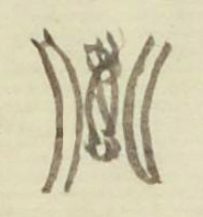Quetzalcoatl (MH643v)
This black-line drawing for the simplex glyph for the personal name Quetzalcoatl is attested as a man's name here. The visual has yet to be deciphered, but it looks something like the bracketing, a set of outwardly curving lines of a ball court as they appear in the Matrícula de Huexotzinco on folio 501 verso. But perhaps they are meant to be quetzal feathers (quetzalli). Between these parallel elements is something that looks like a vertical creature of some sort. Perhaps it is meant to be a serpent (coatl). If the spelling of the deity name is really Quetzalcohuatl, then the serpent is a phonetic indicator, and it has no real place in the translation.
Stephanie Wood
Quetzalcoatl seems a rare and lofty name for an average child of an agricultural community, but perhaps the parents were special devotees of this divine force or deity. See the Mexicolore article about Quetzalcoatl for more information.
Feathered (or "plumed") serpents are known in Mesoamerican art from at least the Olmec period forward to the Spanish colonial period. A short article about Quetzalcoatl in Mexicolore includes this text about the post-Classic period: "The Toltecs lived in the City of Tula (near Mexico City) in the early Postclassic period (900-1200AD). They predated the Aztecs and perhaps even battled with them towards the end of Tula’s cultural and economic dominance in Mesoamerica. They are widely perceived to have spread an active cult of Quetzalcoatl as far south as El Salvador. Parallel to this historic account of Toltec civilization, the Aztecs recorded the myth that the Toltecs were led by a charismatic priest, Ce Acatl Topiltzin Quetzalcoatl (1 Reed Our Lord Quetzalcoatl) (pic 3). Entwined in the annals of history, both god and historical figure became one. Legend says that Ce Acatl Topiltzin and the Toltecs left Tula after being tricked and shamed by Quetzalcoatl’s brother, the deity Tezcatlipoca. They travelled past Cholula (in Puebla), into the Yucatan and Chichén Itzá, and may even have gone as far as El Salvador. Whether the historical figure of Ce Acatl Topiltzin did this, or whether it was the deity Feathered Serpent, we know that Quetzalcoatl was worshipped throughout Mesoamerica up until the conquest in 1521, and that the Aztecs appeared to combine Quetzalcoatl the priest with the deity."
gaspal guetzalguatl
Gaspar Quetzalcoatl
Stephanie Wood
1560
Jeff Haskett-Wood
Quetzalcohuatl, quetzales, águilas, pájaros, plumas, feathers, animales, canchas de pelotas, serpiente emplumada

Quetzalcoatl, divine force/deity or the title of a high priest, https://nahuatl.wired-humanities.org/content/quetzalcoatl
quetzal(li), quetzal feathers, https://nahuatl.wired-humanities.org/content/quetzalli
coa(tl), snake or serpent, https://nahuatl.wired-humanities.org/content/coatl
cuauh(tli), eagle, https://nahuatl.wired-humanities.org/content/cuauhtli
Quetzal-Águila
Stephanie Wood
Matrícula de Huexotzinco, folio 643v, World Digital Library, https://www.loc.gov/resource/gdcwdl.wdl_15282/?sp=369&st=image
This manuscript is hosted by the Library of Congress and the World Digital Library; used here with the Creative Commons, “Attribution-NonCommercial-ShareAlike 3.0 License” (CC-BY-NC-SAq 3.0).








